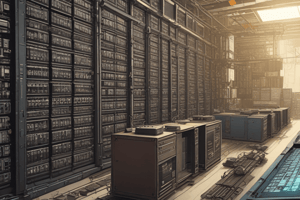Podcast
Questions and Answers
What is the role of cache memory in the CPU?
What is the role of cache memory in the CPU?
- It powers the CPU.
- It stores all the data permanently.
- It temporarily stores frequently used instructions for quicker processing. (correct)
- It stores images and videos.
Where is cache memory located?
Where is cache memory located?
- On the motherboard.
- Inside the main memory.
- Inside the CPU. (correct)
- Outside the computer.
What is another name for secondary storage?
What is another name for secondary storage?
- CPU memory.
- Virtual memory.
- Auxiliary storage. (correct)
- Primary memory.
Why is cache memory used?
Why is cache memory used?
How does the speed of cache memory compare to main memory?
How does the speed of cache memory compare to main memory?
Which is not a characteristic of secondary storage?
Which is not a characteristic of secondary storage?
What type of memory is known for its high speed and availability inside the CPU?
What type of memory is known for its high speed and availability inside the CPU?
What does the cache memory store?
What does the cache memory store?
Which type of memory is directly accessible by the CPU?
Which type of memory is directly accessible by the CPU?
What type of primary storage loses its contents when the computer is switched off?
What type of primary storage loses its contents when the computer is switched off?
Which type of memory is used to store the instructions to start up the computer?
Which type of memory is used to store the instructions to start up the computer?
Which memory type is non-volatile and cannot be changed by the user?
Which memory type is non-volatile and cannot be changed by the user?
What is another name for primary storage?
What is another name for primary storage?
How does the CPU access secondary storage?
How does the CPU access secondary storage?
Flashcards are hidden until you start studying
Study Notes
Computer Storage
- A computer uses two types of storage: primary storage and secondary storage.
Primary Storage
- Also known as internal or main memory.
- Stored in memory chips that can be accessed by the computer's processor.
- The CPU continuously reads and executes the instructions stored in primary storage.
Types of Primary Storage
- Read Only Memory (ROM)
- Non-volatile memory.
- Contents cannot be changed by the user.
- Contents are not lost when the computer is switched off.
- Used to store instructions to start up the computer.
- Random Access Memory (RAM)
- Volatile memory.
- Used to store programs and files currently being used by the processor.
- Loses its contents when the computer is switched off.
Cache Memory
- High-speed memory available inside the CPU.
- Temporarily stores frequently used instructions for quicker processing.
- Sits between the CPU and main memory.
Secondary Storage
- Also known as external memory, auxiliary storage, or backing storage.
- Not directly accessible by the CPU.
- Accessed through the computer's input/output channels.
- Slower than primary storage due to the use of input/output channels.
Primary and Secondary Storage
- A computer uses both primary and secondary storage, differing in accessibility by the CPU.
- Primary storage is directly accessible by the CPU, whereas secondary storage is not.
Primary Storage
- Also known as internal or main memory, stored in memory chips accessible by the processor.
- The CPU continuously reads instructions stored in primary storage and executes them as required.
- There are three types of primary storage:
- Read Only Memory (ROM)
- Non-volatile memory, contents cannot be changed by the user and are not lost when the computer is switched off.
- Used to store instructions to start up the computer.
- Random Access Memory (RAM)
- Volatile memory, used to store programs and files currently being used by the processor.
- Loses its contents when the computer is switched off.
Studying That Suits You
Use AI to generate personalized quizzes and flashcards to suit your learning preferences.




